How to Grow Muscadine Vines At Home
As an Amazon Associate and member of other affiliate programs, I earn from qualifying purchases.
Growing muscadine vine is much easier than traditional grapes. In fact, you haven’t had a grape until you’ve tried a Muscadine. These wild, juicy fruits are a Southern specialty and have thick plumb-like skin.
There isn’t another grape quite like it—the flavor is intensely sweet and the grape will absolutely melt in your mouth. Thankfully, growing muscadine is not too difficult once you know what to do.
With a little effort, you’ll be enjoying a harvest of juicy muscadines all season long.
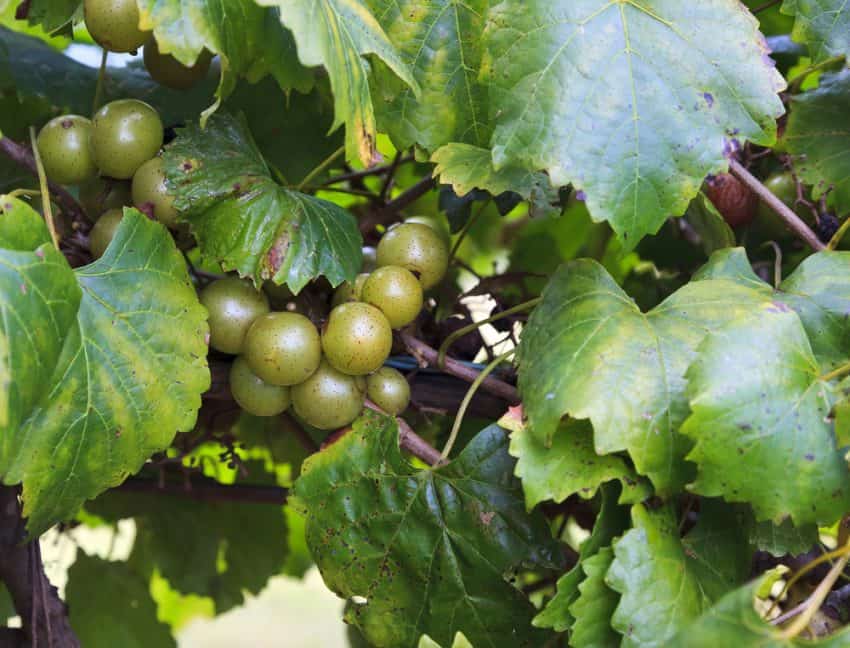
How to Grow Muscadines
There are several steps to take when you decide to start growing muscadines for the first time. Once you get these basics down, you’ll be well on your way to a juicy burst of grape flavor.
Growing Muscadines: Pick Your Varietal
There are dozens of muscadine varieties, so the first step is to decide exactly which one you’d like to grow.
A few of the most popular options are:
- Scuppernong – large, round slightly copper green grape
- Fry* – larger, sweeter seedless grapes that bear heavy fruit
- Scarlet – mild-flavored large red grapes
- Cowart* – these black grapes are one of the largest varietals
- Nesbitt* – large juicy hybrid of the fry and cowart grapes
- Noble* – these small grapes are ideal for wine and jelly making
- Triumph* – these are the classic extra large and juicy grape
*self-pollinating – I generally recommend you start with one of these grape types as a beginner, as they are much easier to grow than those which require pollination.
Where To Start Growing Muscadines
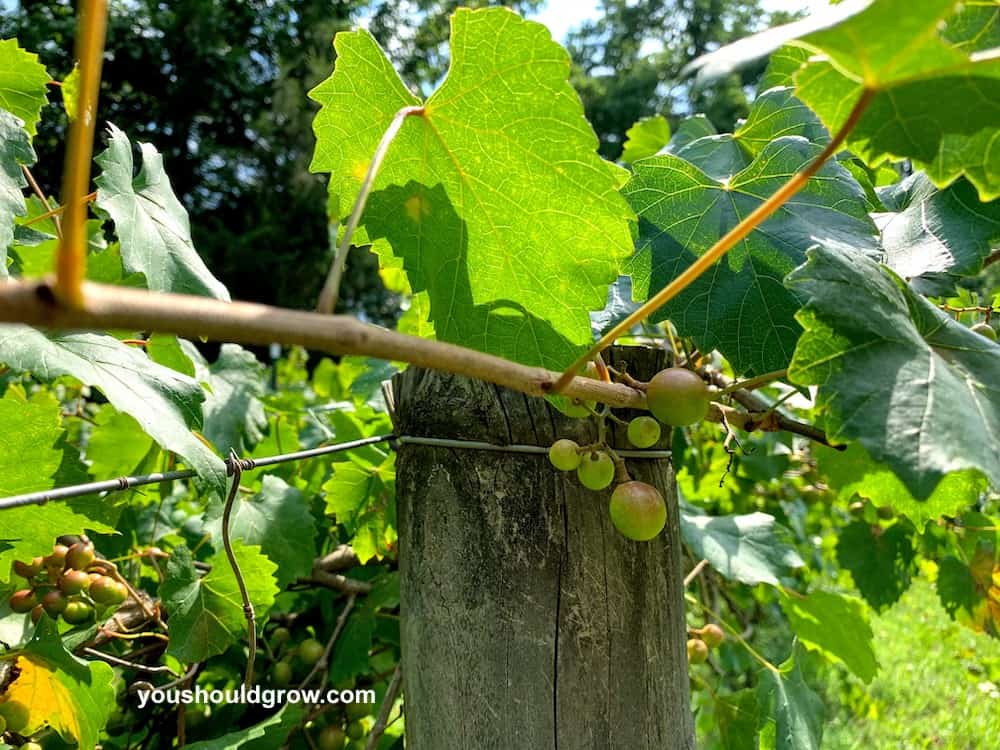
Once you know which grape you’ll be growing, you’ll need to select the ideal location so it can flourish. You will need a location that gets plenty of sun—muscadines require at least six hours of direct sunlight but do even better with eight to ten.
You’ll also want to make sure the area has excellent drainage. If you have a swampy area, it’s not the spot to grow grapes! Also make a plan for your trellis as these vines need something to grow on.
How to Grow Muscadine Grapes from the Seed
I don’t generally recommend growing from the seed in this case since it will take about a year to see some results. However, if you want to try it and have the time and patience, there’s certainly no reason why not!
Here’s the quick way to grow muscadine grapes from seed:
- Remove seed from pulp and rinse with lukewarm water. Let it dry on a paper towel for 24 hours.
- Place the seed into a plastic baggy half full with damp peat moss. Seal the bag
- Place the baggy in the refrigerator for 3 months.
- Place the 2-3 seeds into a 4-inch pot that are 3/4ths full of soil. Push the seeds down 1/4th of an inch into the soil – you’ll need to maintain a temperature of about 75 degrees F
- The pot needs to be in an area with bright, indirect light.
- Mist the soil with lukewarm water.
- Germination happens within 3 weeks.
- Afterward, keep the seedlings in bright light and transfer to 6-inch pots
- After a full year of growth in the pots, transfer the seedlings to the ground.
How to Start Planting and Growing Muscadine Grapes from a Root Vine
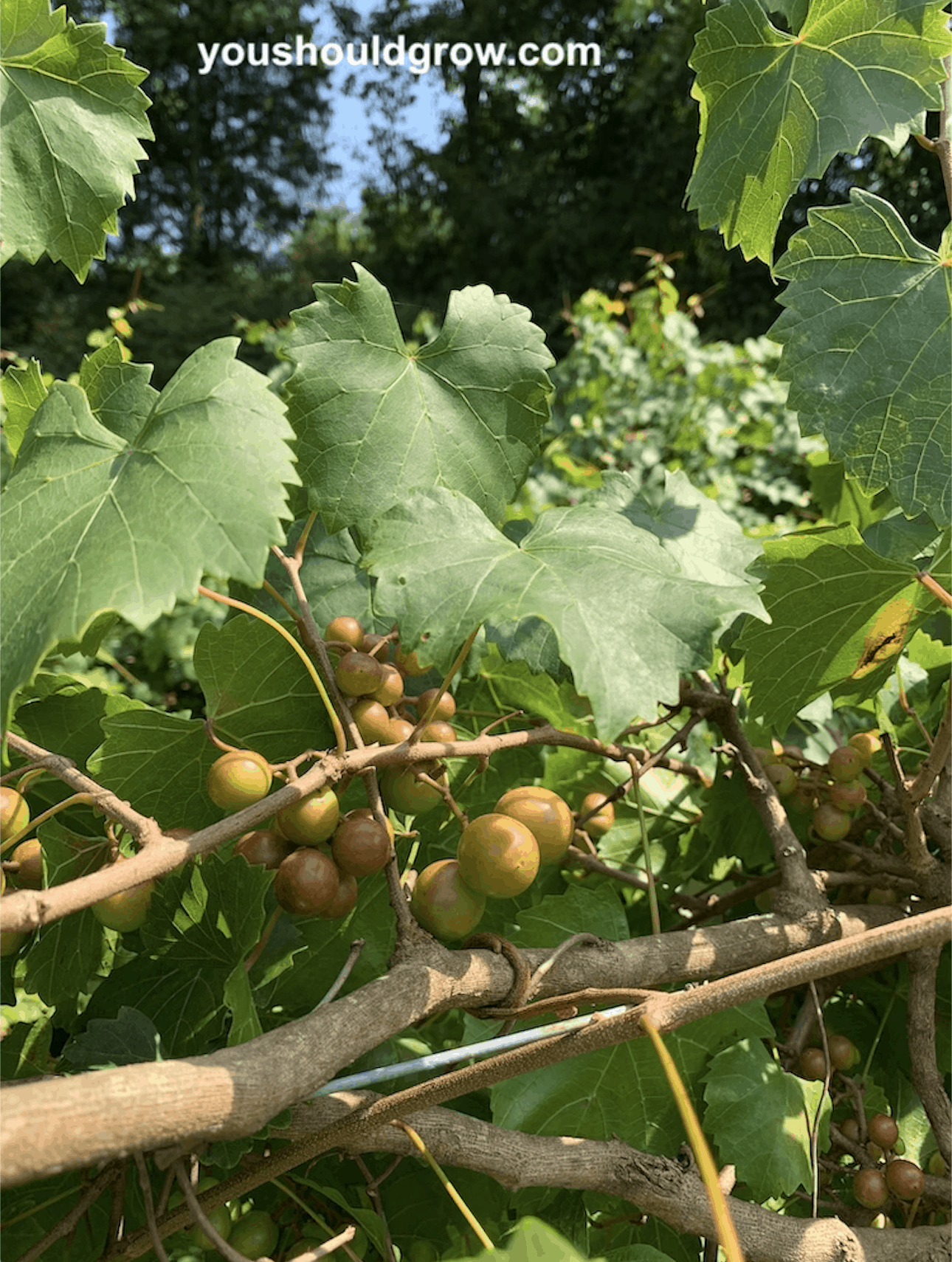
The more common way to start growing muscadine is to start with a bare root vine. You can order these, or bribe a friend with a thriving muscadine to give you part of one.
Like all grapes, muscadines must be trellised, and grow upwards from the ground. You want about 20 feet of trellis for each muscadine vine. It may sound like a lot, but the grapevine will grow quickly. You can use fence posts to string a trellis in between or purchase a decorative trellis instead.
If you are starting with bare-root vines, they are best planted in the spring after the danger of frost has passed. To plant your vine, dig a hole at the base of the trellis post, then place the vine in the hole with the roots fanned out about 1 inch below the soil line.
Then, add a phosphate-rich soil into the ground until the whole is three-quarters full. Water well, then finish filling the hole with the last 1/4th of the dirt and water again.
Once the vines are established they can tolerate dry weather. However, young vines or vines that are producing fruit will need extra watering and irrigation.
Tips for Growing Muscadine
Every plant has it’s special quirks, and muscadine is certainly no exception. Here are some helpful tips and tricks to keep your vines healthy and loaded with fruit.
Make sure they are Pollinated
If you opted to purchase a self-fertilizing variety (marked with an asterisk above), you don’t need to worry about this step. However, for other types of grapes, there is a fairly extensive hand-pollination process that is crucial to the success of the grape.
Help the Vines Start
When your muscadine vines start to grow, they may need a little help becoming attached to the trellis at first. To give them a helping hand, you can loosely attach the vines to the trellis with cord.
If they are especially small, you can even attach them to a stake at the beginning, then plant the trellis behind the stake when it’s needed.
Prune Regularly and Correctly
A big part of your success with growing muscadine grapes comes down to pruning the plants properly. The trick to growing muscadine is to prune the vines back to only the most vigorous vine every season.
This means you are looking for the highest climbing, thickest vine to keep, then pruning away the weaker ones. It seems harsh but it’s vital to the getting fruit as the grapes will form on new growth in the spring and summer.
It’s important that you prune them at the right time. These vines need to be pruned at the beginning of the year before they start putting out new growth for the biggest harvest of grapes come summer.
Harvest at the Right Time
The best part of learning how to grow muscadine? Getting to harvest them at the end, of course. Harvesting the muscadine grapes should take place in late summer. The grapes will be individuals on the vine and can be removed with very little effort when they are ready.
While they are great for fresh eating, you absolutely must try making some muscadine jelly. It’s as southern as buttermilk biscuits!
Are you going to try growing muscadine?
What’s your favorite variety?



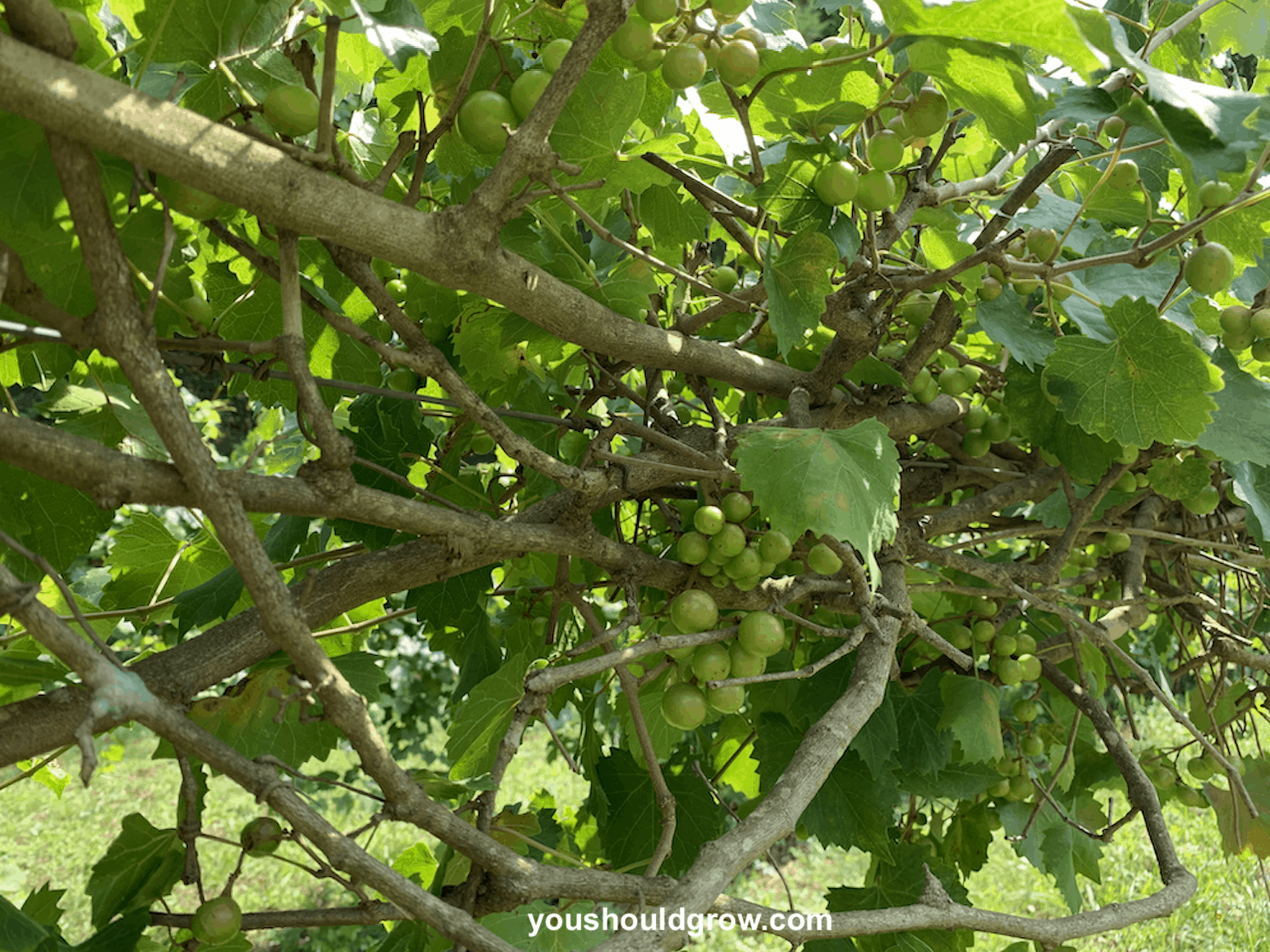


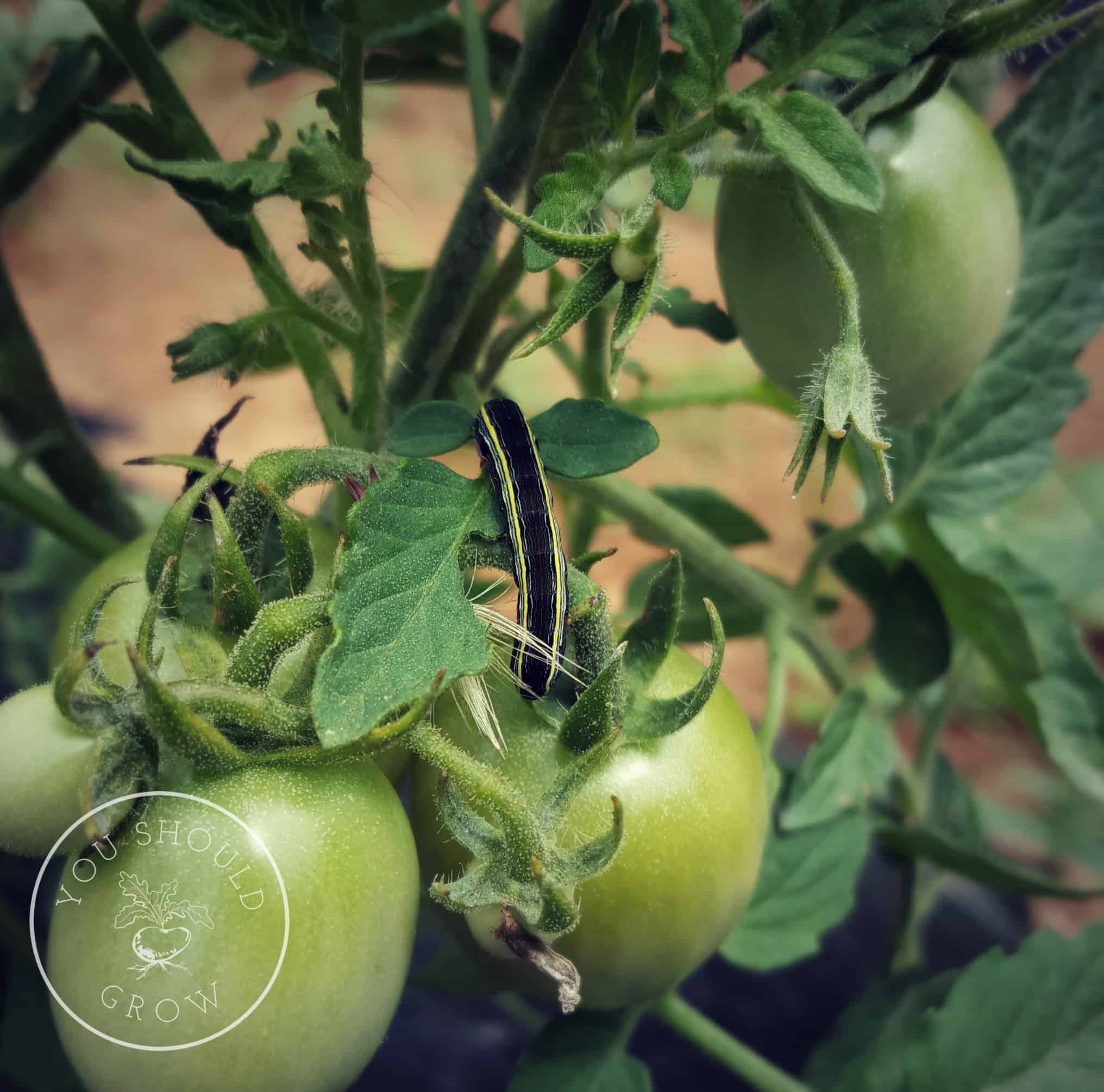



I have discovered a place on my property that is covered in muscadine grapevine. The good news is also the bad news! I watched last year and this spring I see NO grapes! Zero, zilch! Not one! I suspect they need more sun. If I clear out some trees and get them up off the ground, do you think wild muscadine can produce a crop?
Hey, Becky! Yes, they absolutely will! Clearing out the trees is a good idea, and I also suggest pruning back the vines early next year. Grapes will form on new growth, so giving them a hard trim will encourage them to make fruit!
what’s the best way to root cuttings from Muscadine’s or grapes?? I also have some hybirds May haws I would like to propagation from cuttings.and whats the best rooting hormone to use ?
Hi, Danny! You can root cuttings from the soft growing tips of muscadine vine. Coating the cut end with rooting hormone can help it get started. The cutting with rooting hormone should be placed about an inch deep into a pot full of germinating mix. Keep it moist while it’s getting started. I would use whatever rooting hormone you already have or can find at the garden center. I’ve even heard honey will work!
Are these up north?
I have just collected some seeds but was unaware of putting them in a moist plastic back with moss and storing in the refrigerator. I’ve probably had them out drying for 3 weeks…is that too late to NOW put them in a bag and put them in the fridge?